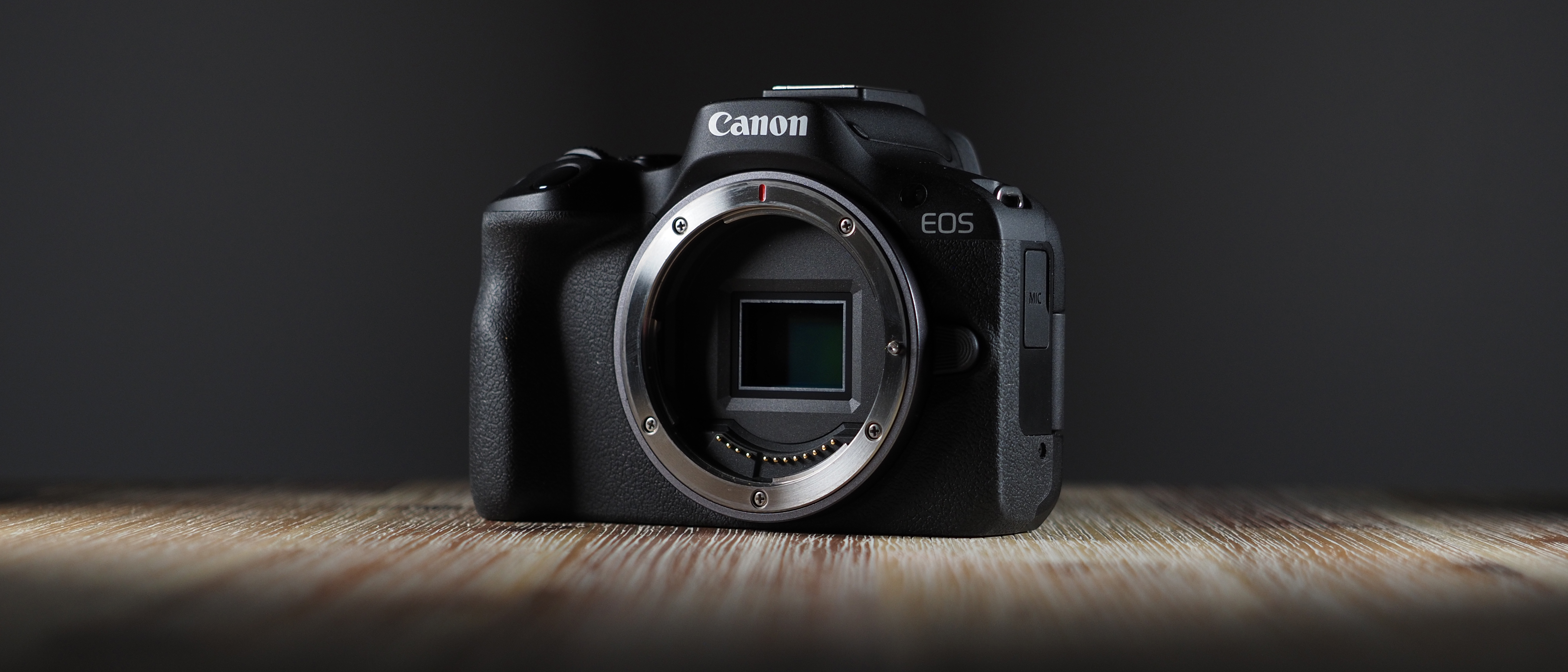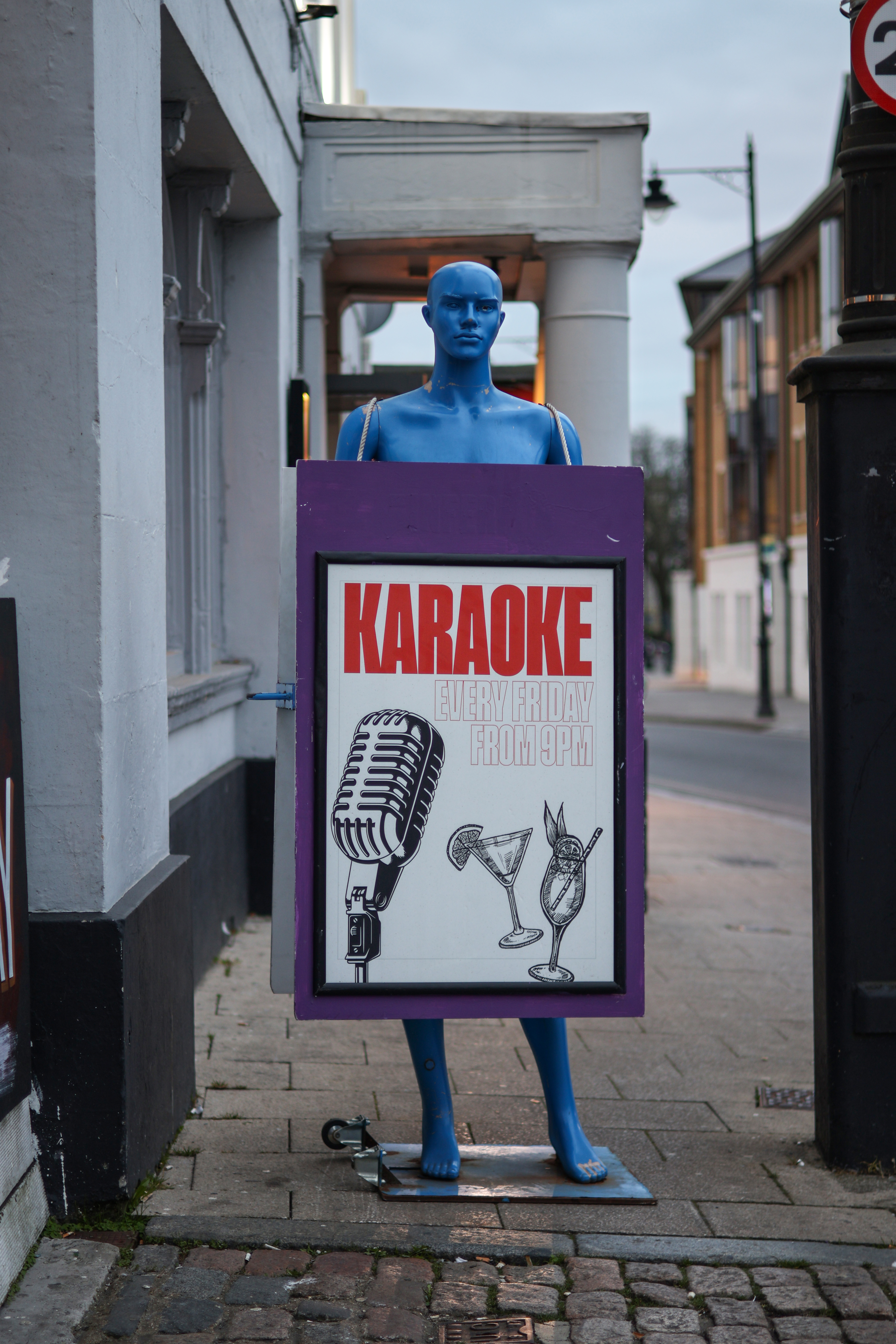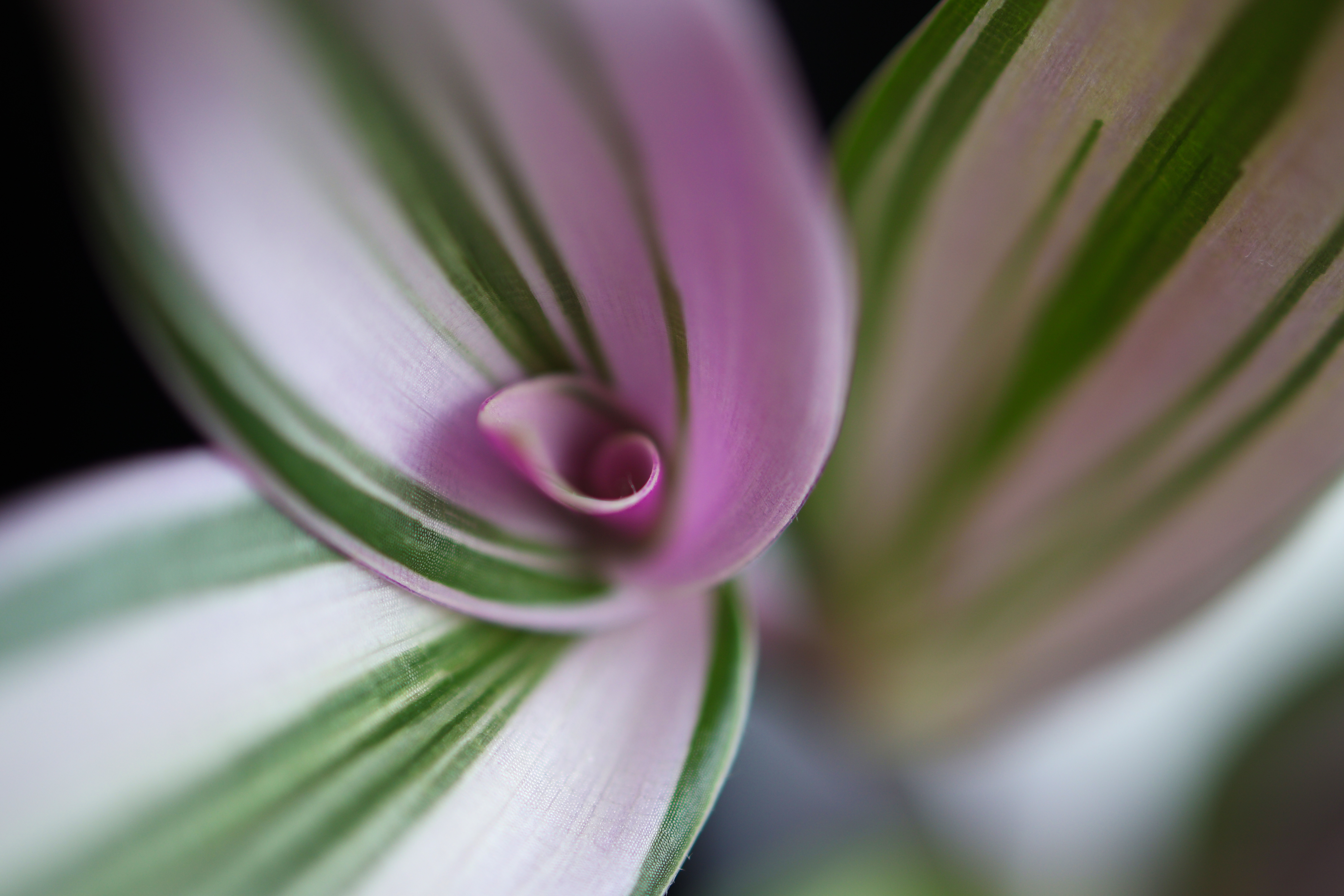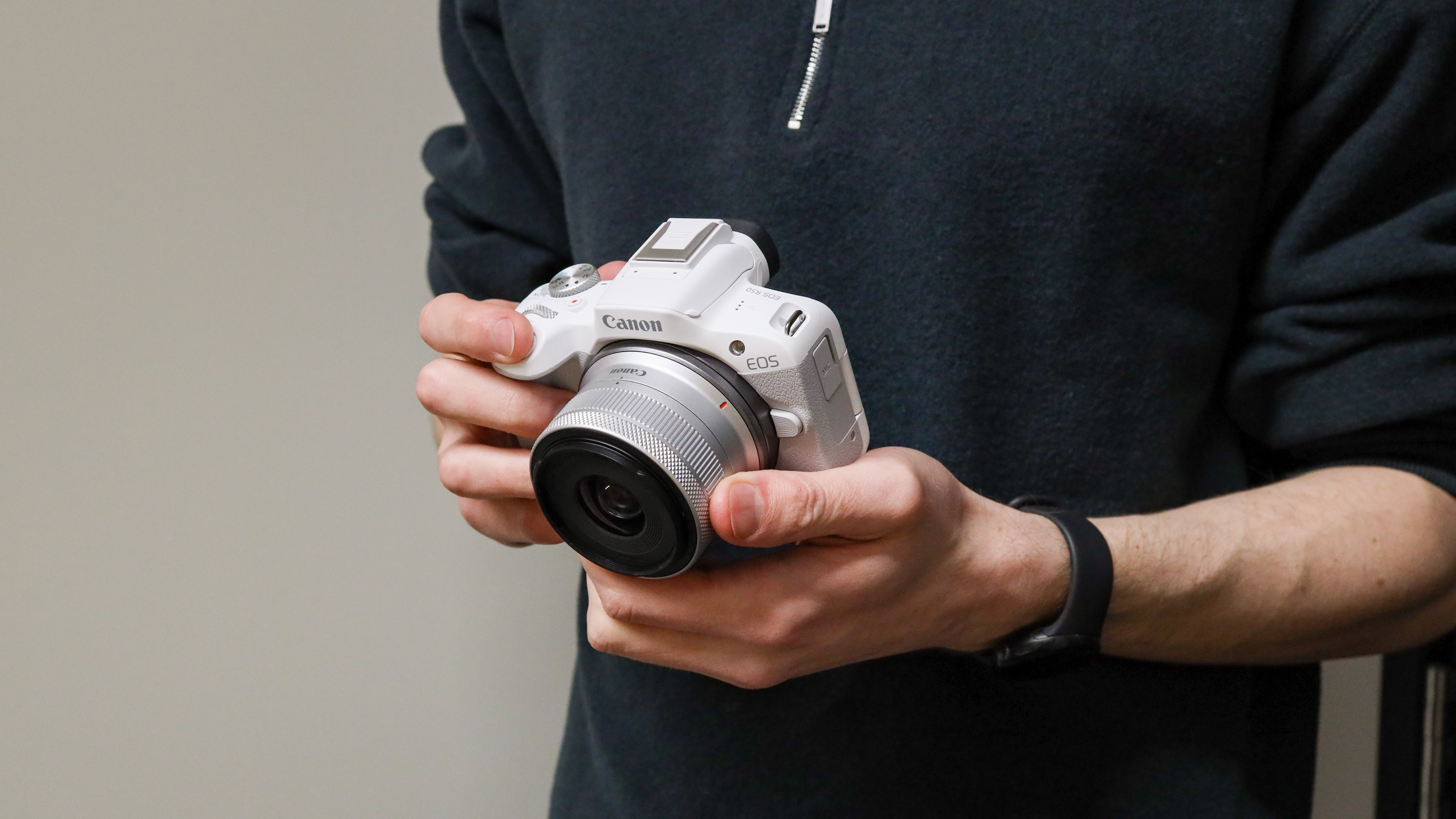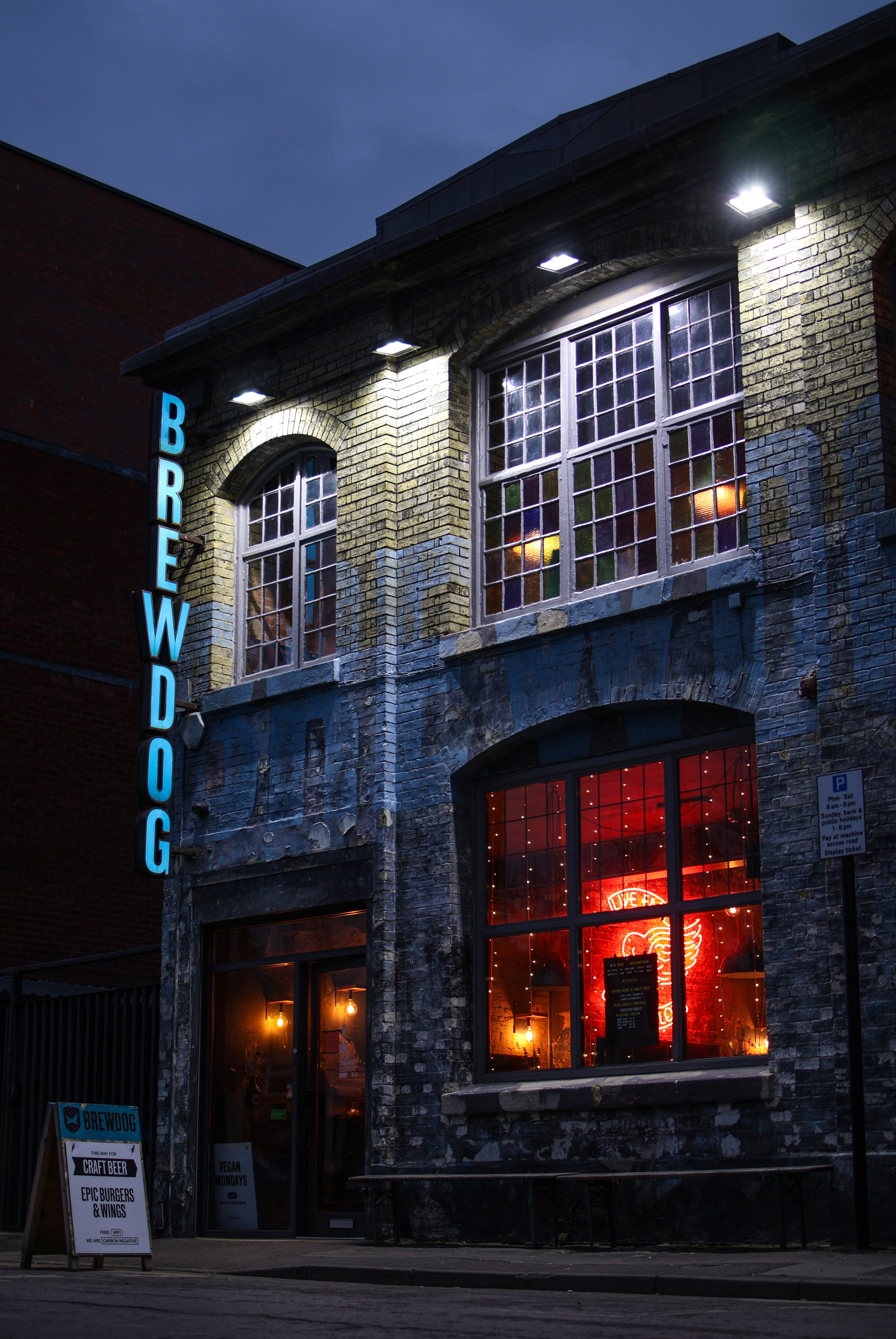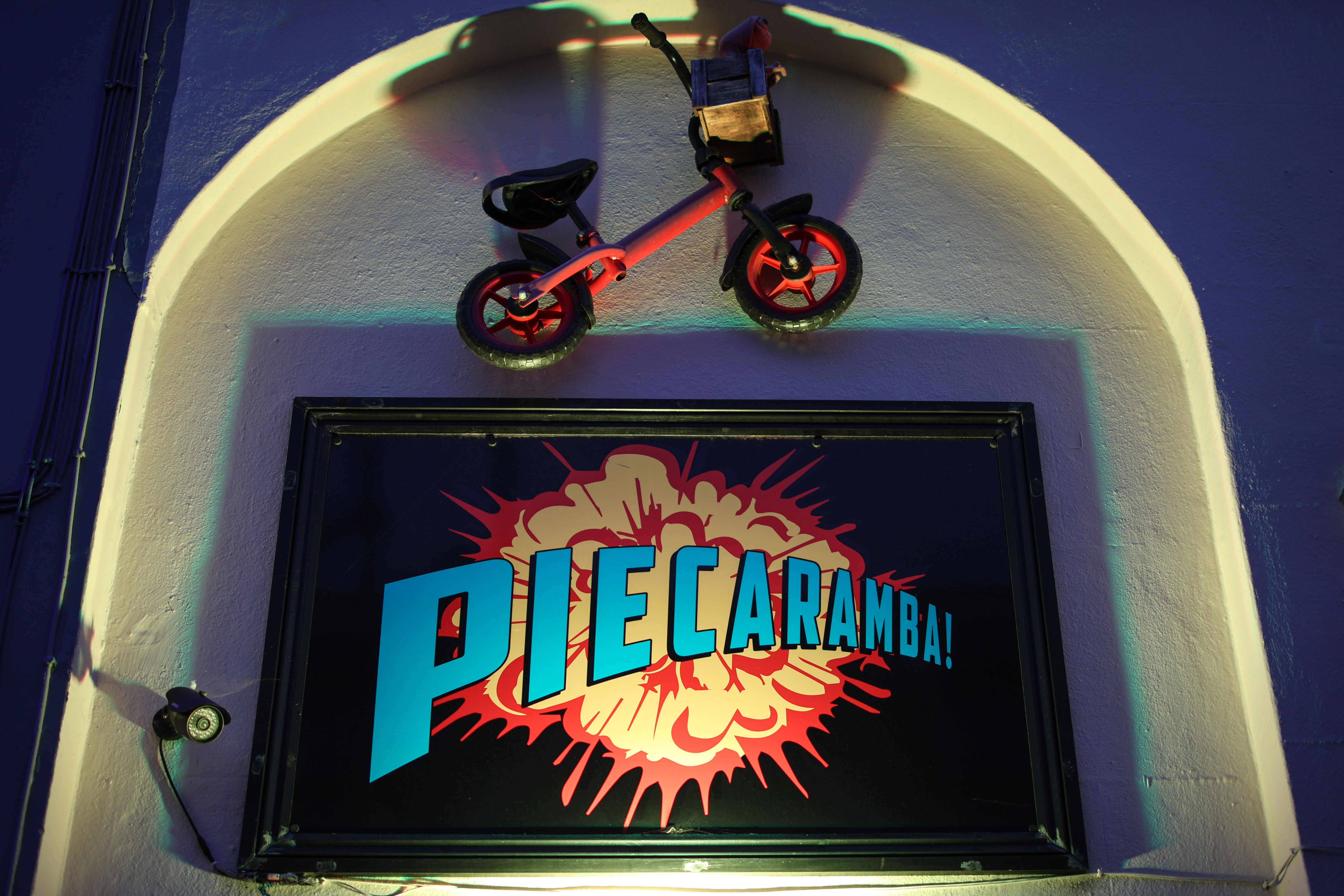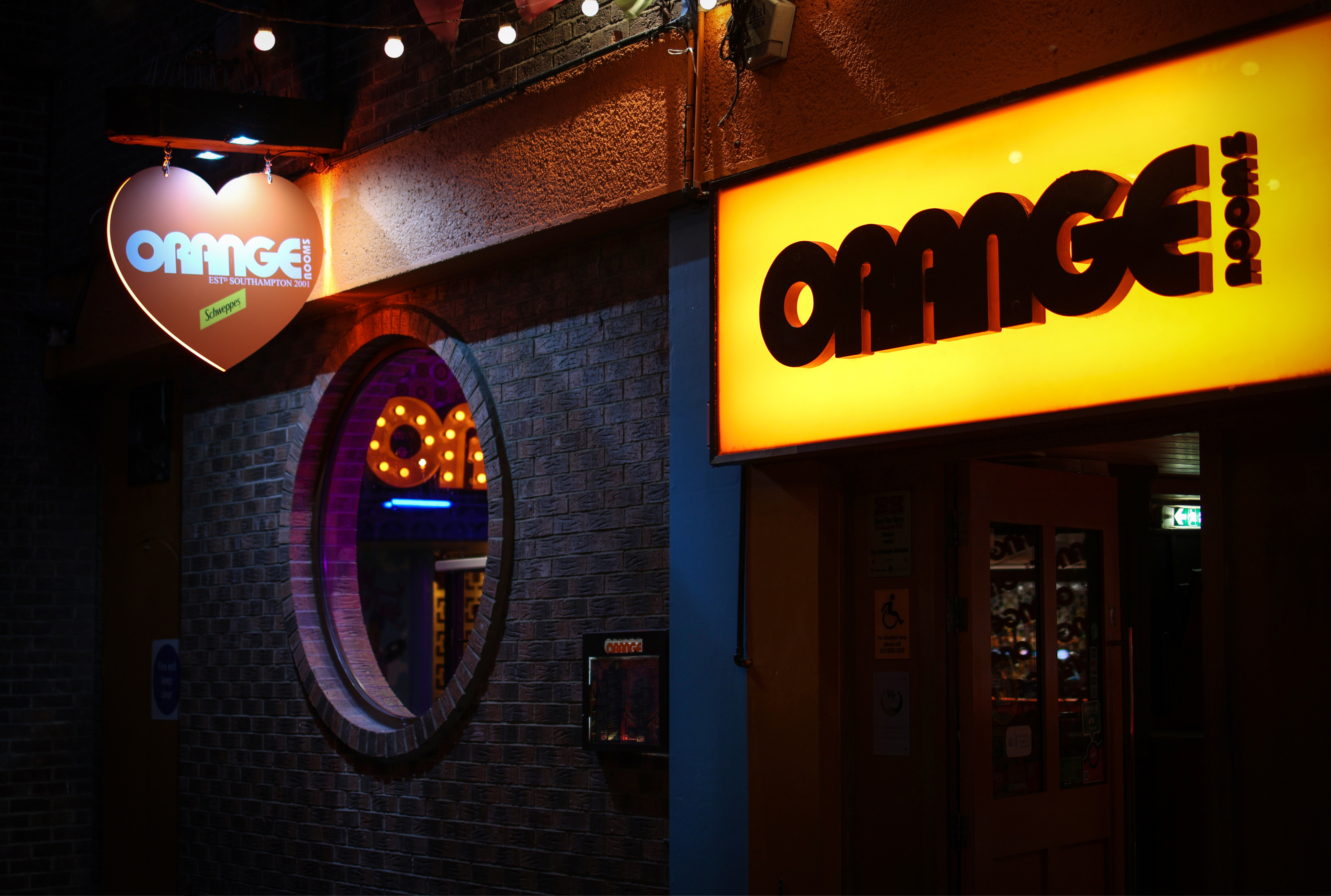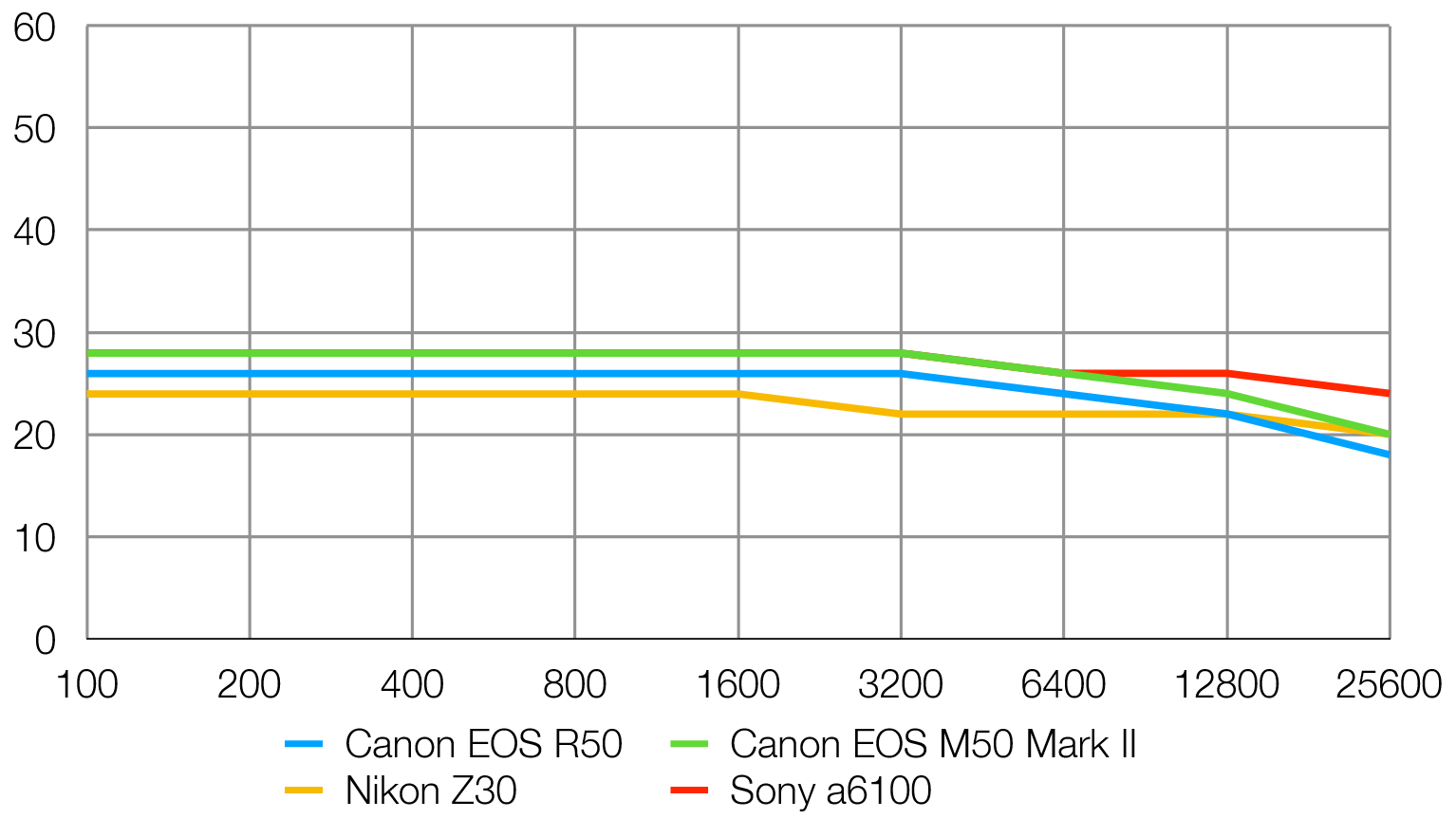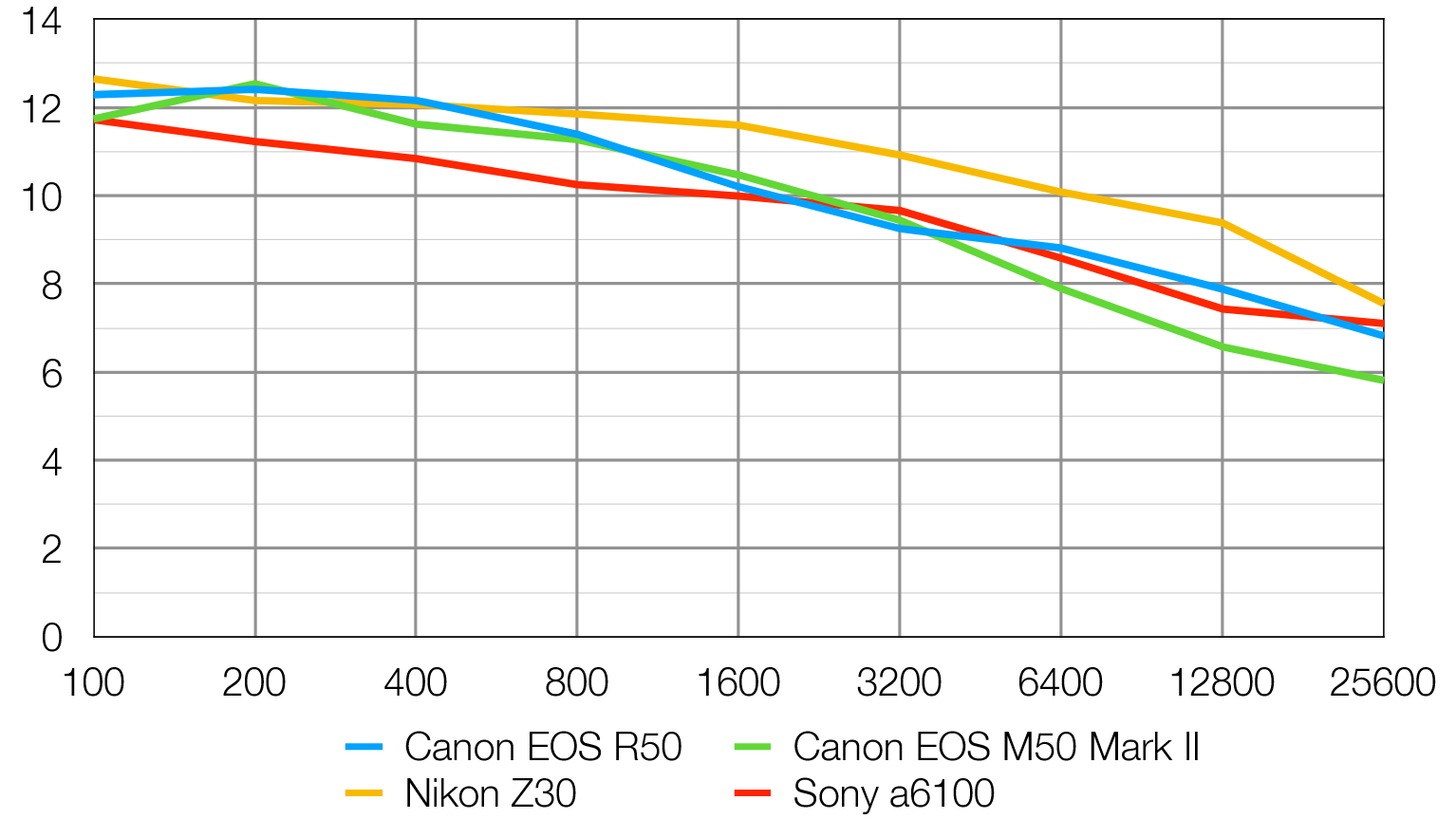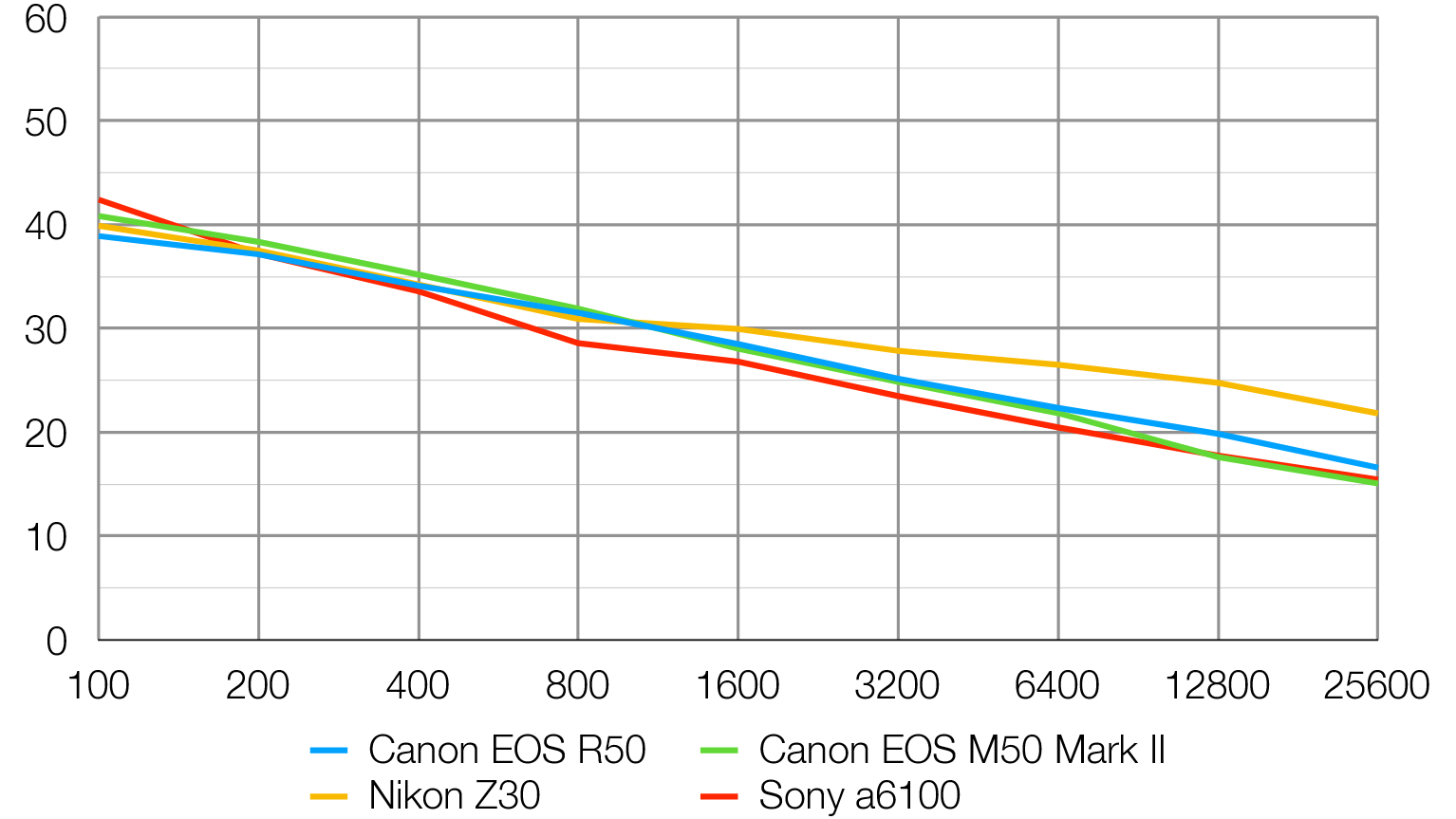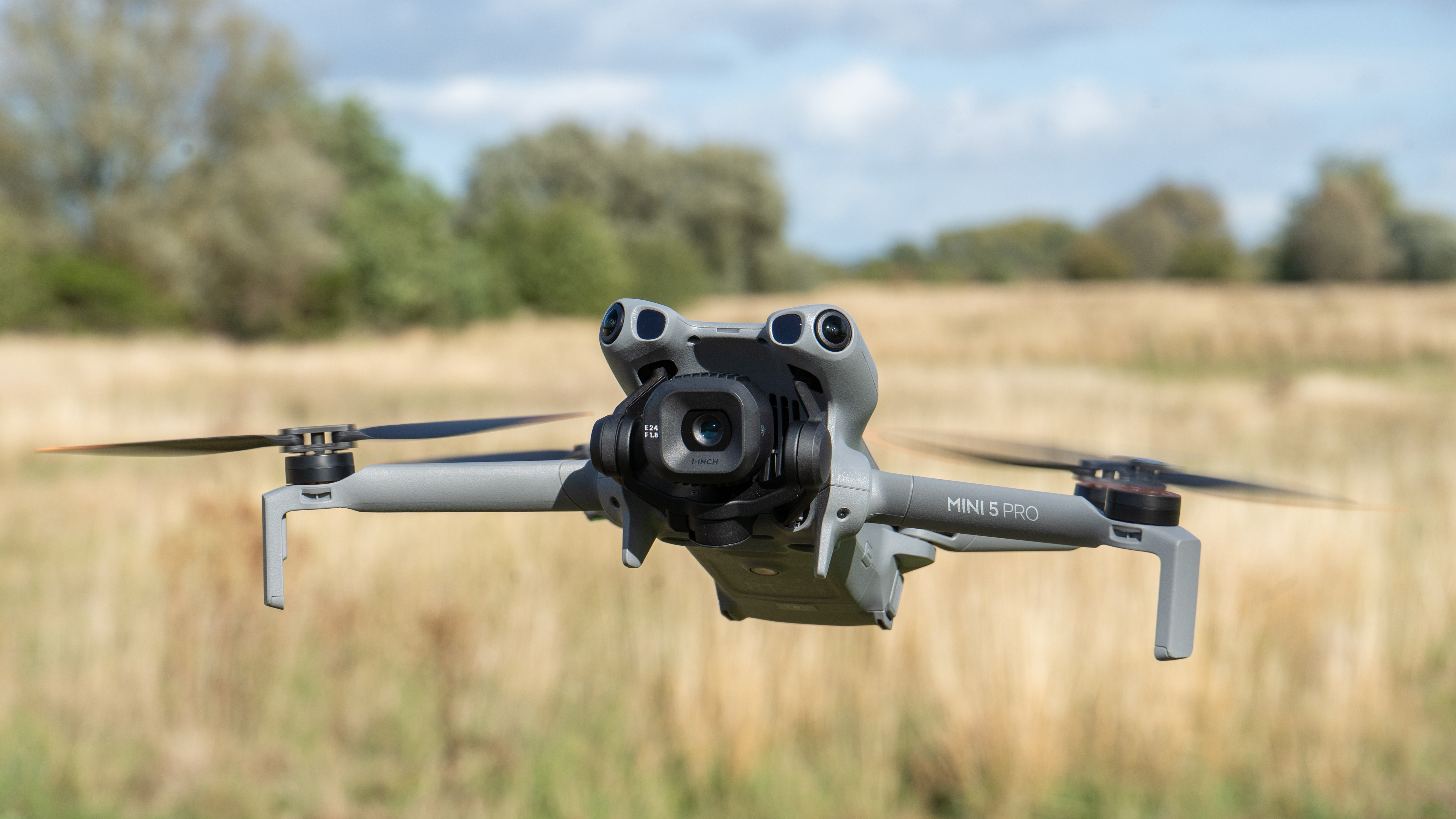Digital Camera World Verdict
The Canon EOS R50 is what would happen if the M50 Mark II and the R10 had a baby. Carrying over the incredibly small and compact size of the M50 and improving on its specs in every way, with the excellent sensor and processor from the R10, the R50 makes a serious play to be one of the best pocket-friendly cameras today. With a 24.2MP APS-C sensor, capable of full-width 4K with a wealth of social media-friendly shooting modes, this camera might be the content creator's new best friend.
Pros
- +
Smallest, lightest EOS R camera
- +
Simple to use with guided UI
- +
Social media & vlogging features
Cons
- -
Lacks the latest tracking options
- -
Only one control dial
- -
Too small for most RF lenses
Why you can trust Digital Camera World
Long story short: the Canon EOS R50 is basically a newer, cleverer replacement for the M50 line. Even though the M50 will continue to be sold, and the EOS M system will still be supported.
Still, it's pretty inarguable that the Canon EOS R50 is the spiritual replacement for the Canon EOS M50 Mark II, released in 2020 (as a very marginal update to the original Canon EOS M50 from 2018). And the R50 manages to supersede its predecessor in almost every way.
Its compact size and all-around capability qualifies it as one of the best travel cameras, with its low cost of entry and beginner-friendliness continuing the M50 lineage as one of the best cameras for vlogging.
The fact that it shares the same RF mount as EOS R cameras like the Canon EOS R5 and Canon EOS RP (rather than the far less populated EF-M mount, which limits the EOS M range) gives the R50 access to a rich, cutting-edge and ever-increasing line of lenses. Though at the same time, this does create an issue where a tiny camera has to use lenses designed for bigger bodies.
Here's the full story of how the Canon EOS R50 breaks down, what it does, who it's for, and where it stands in Canon's increasingly complex catalog.
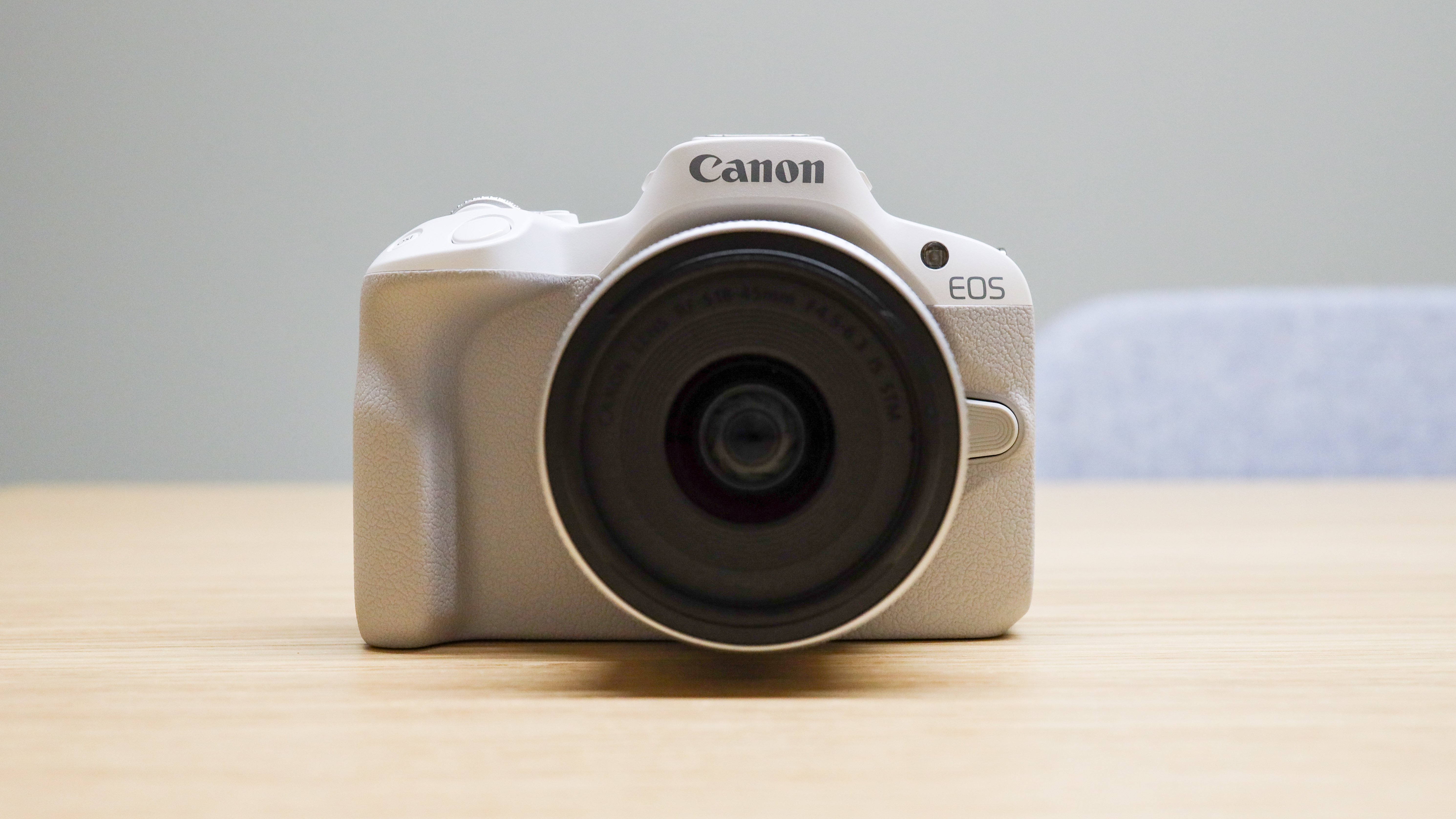
The Canon EOS R50 comes in black and white color options
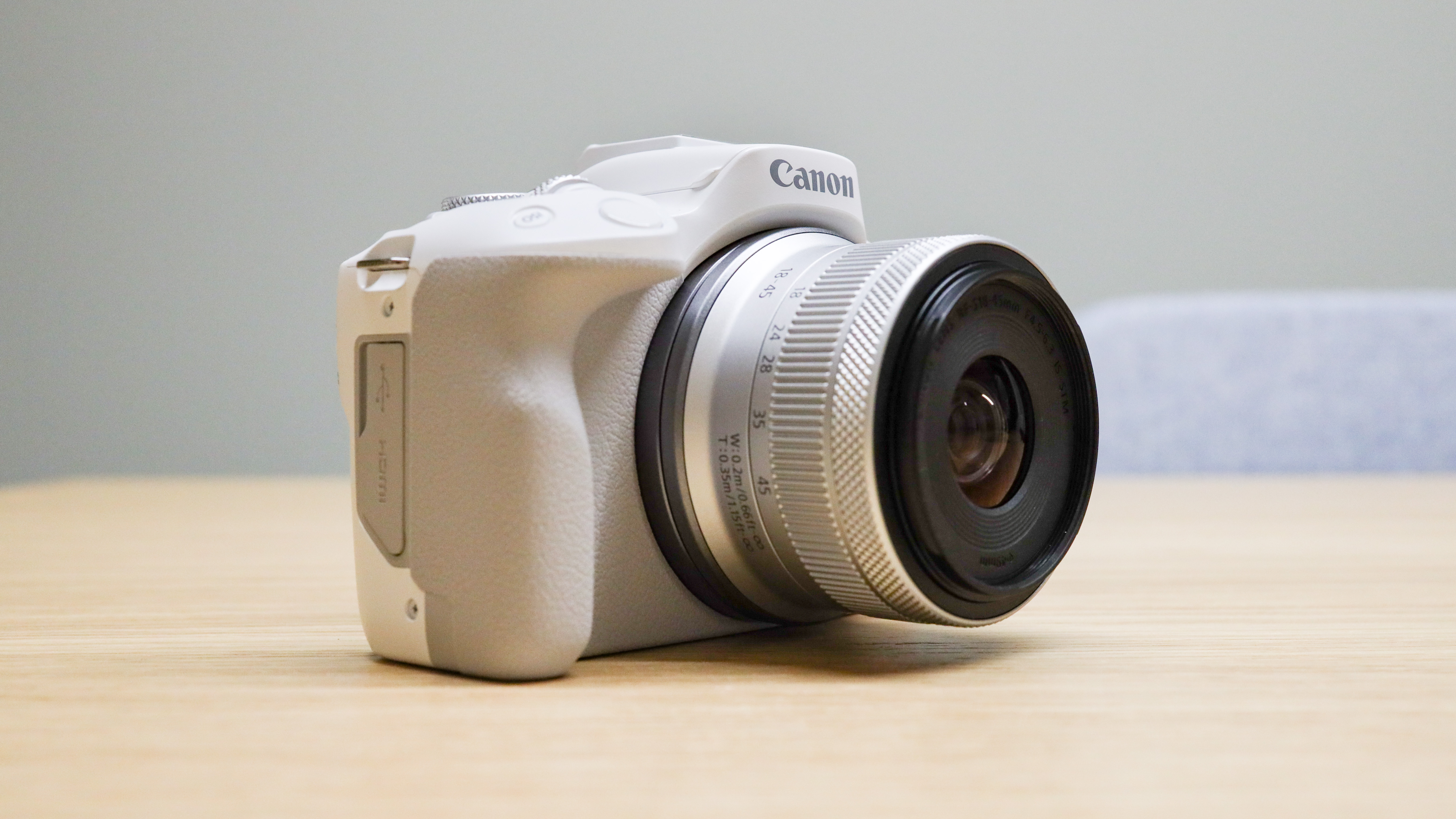
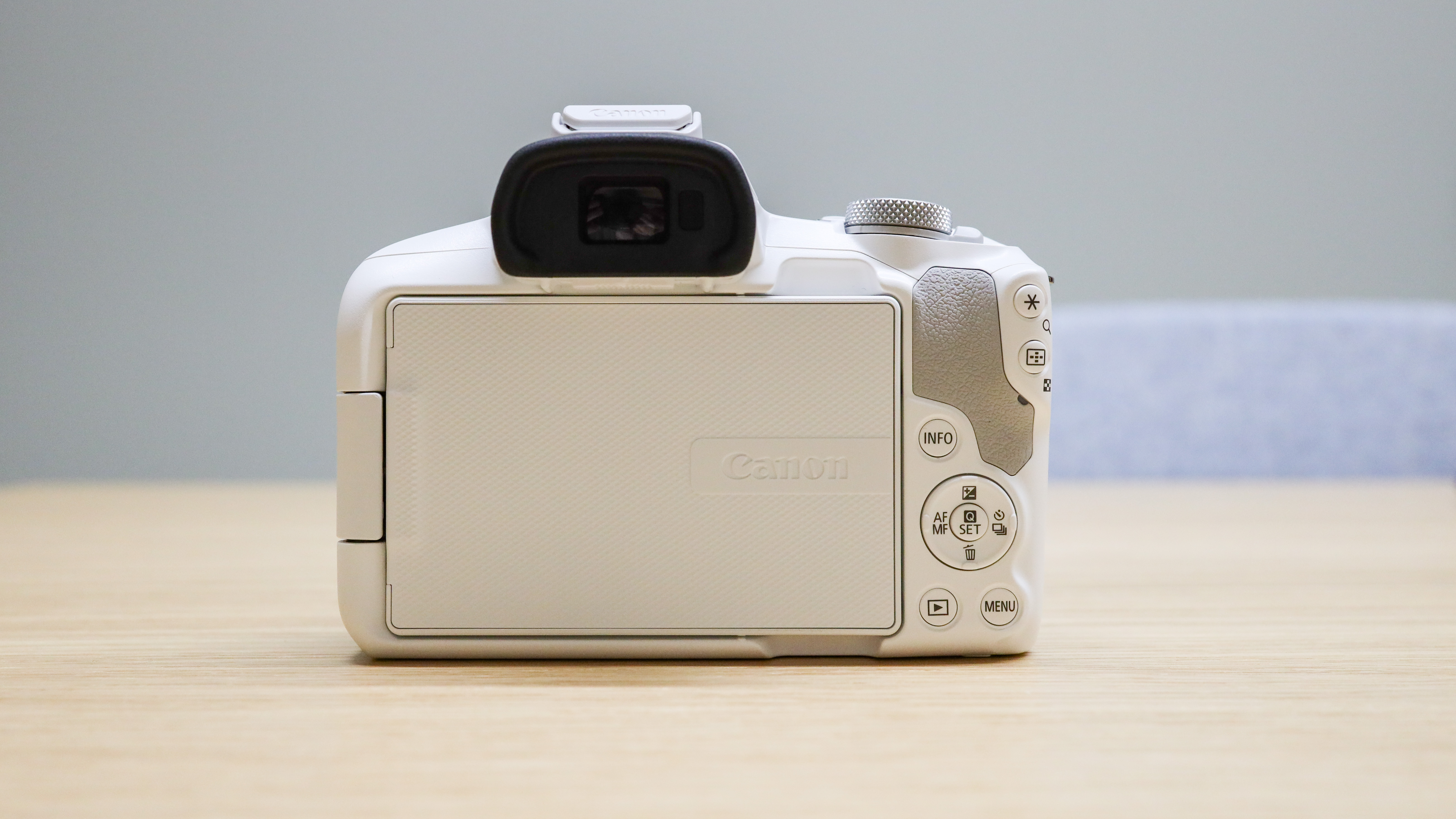
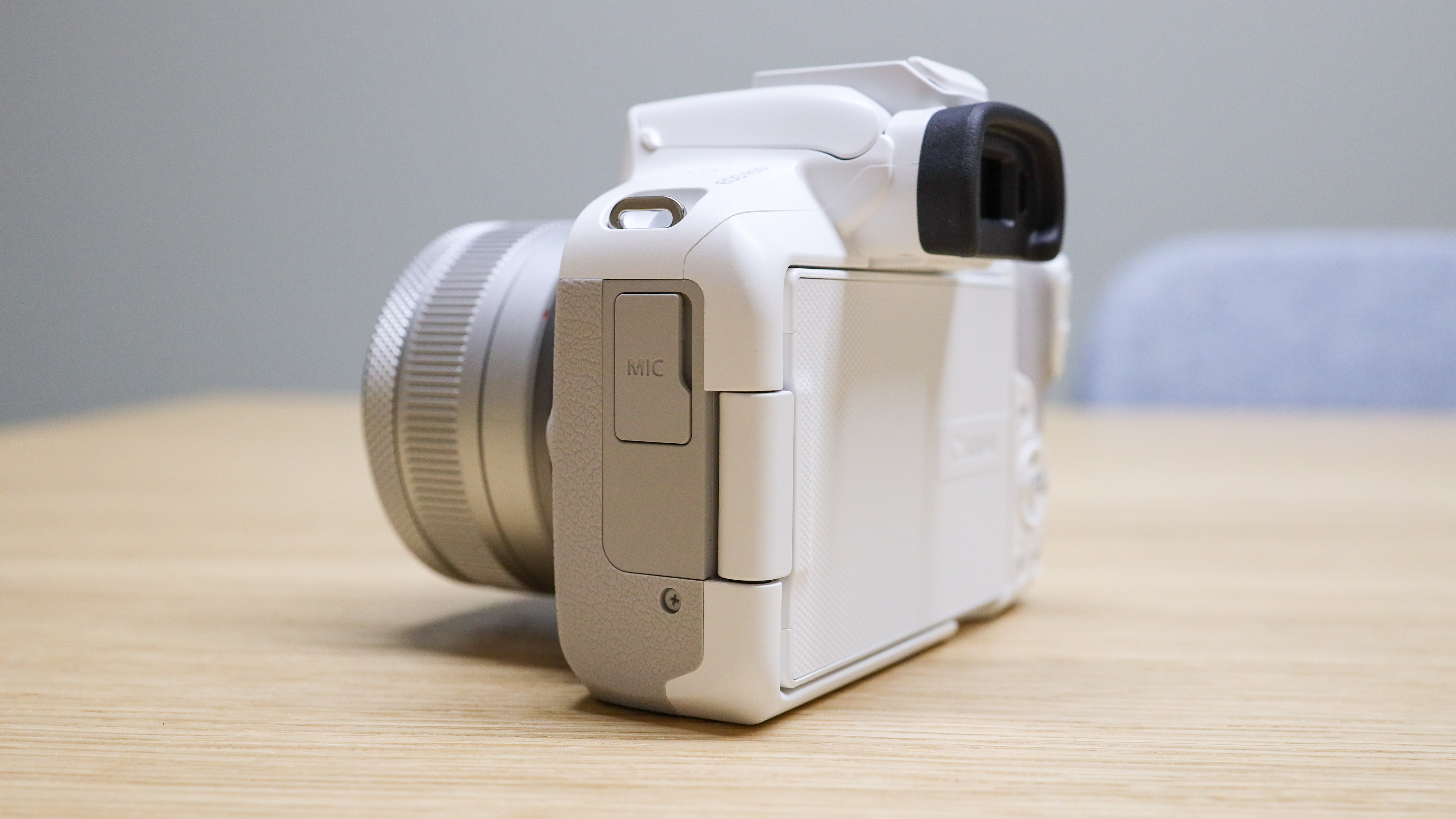
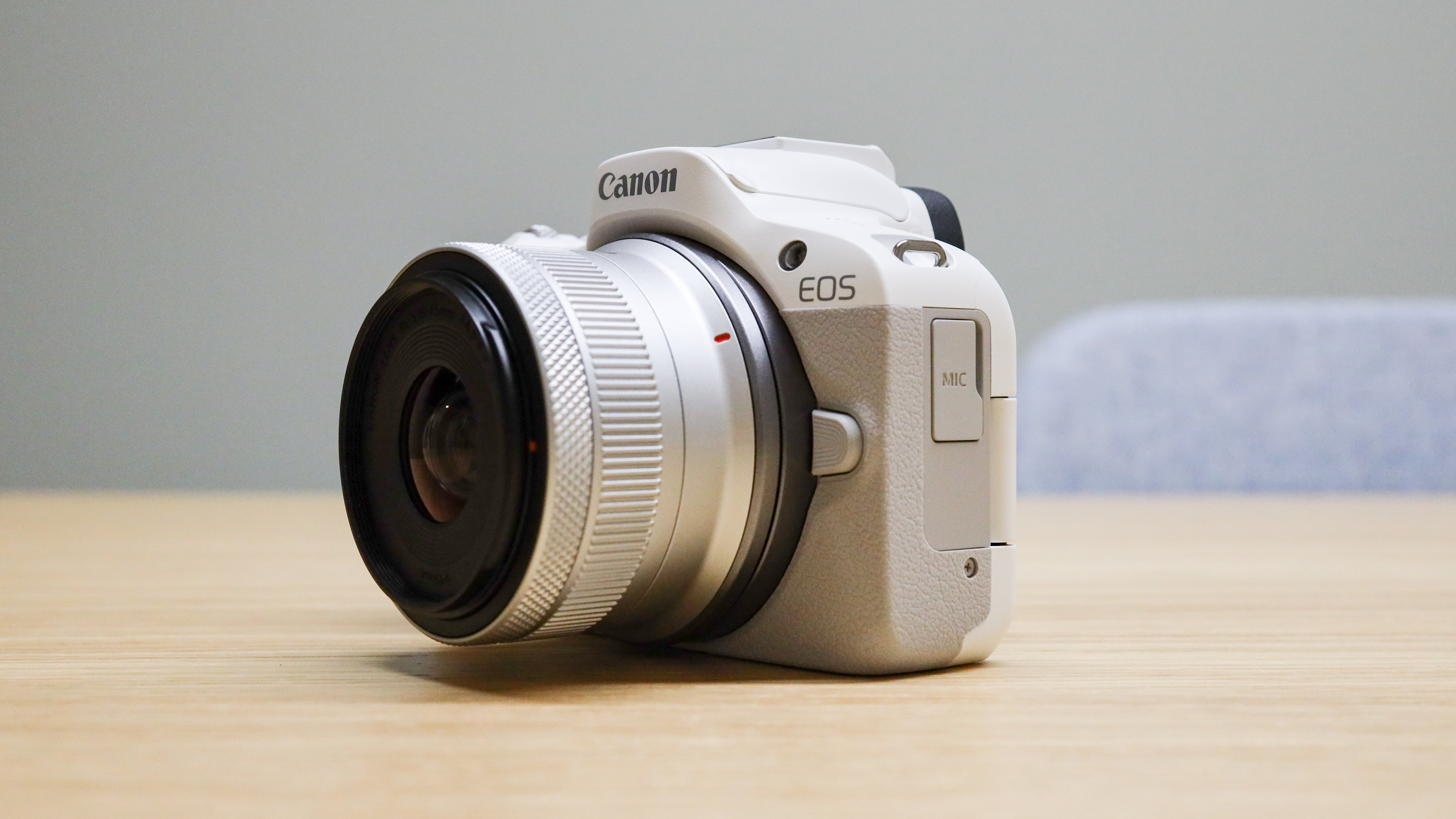
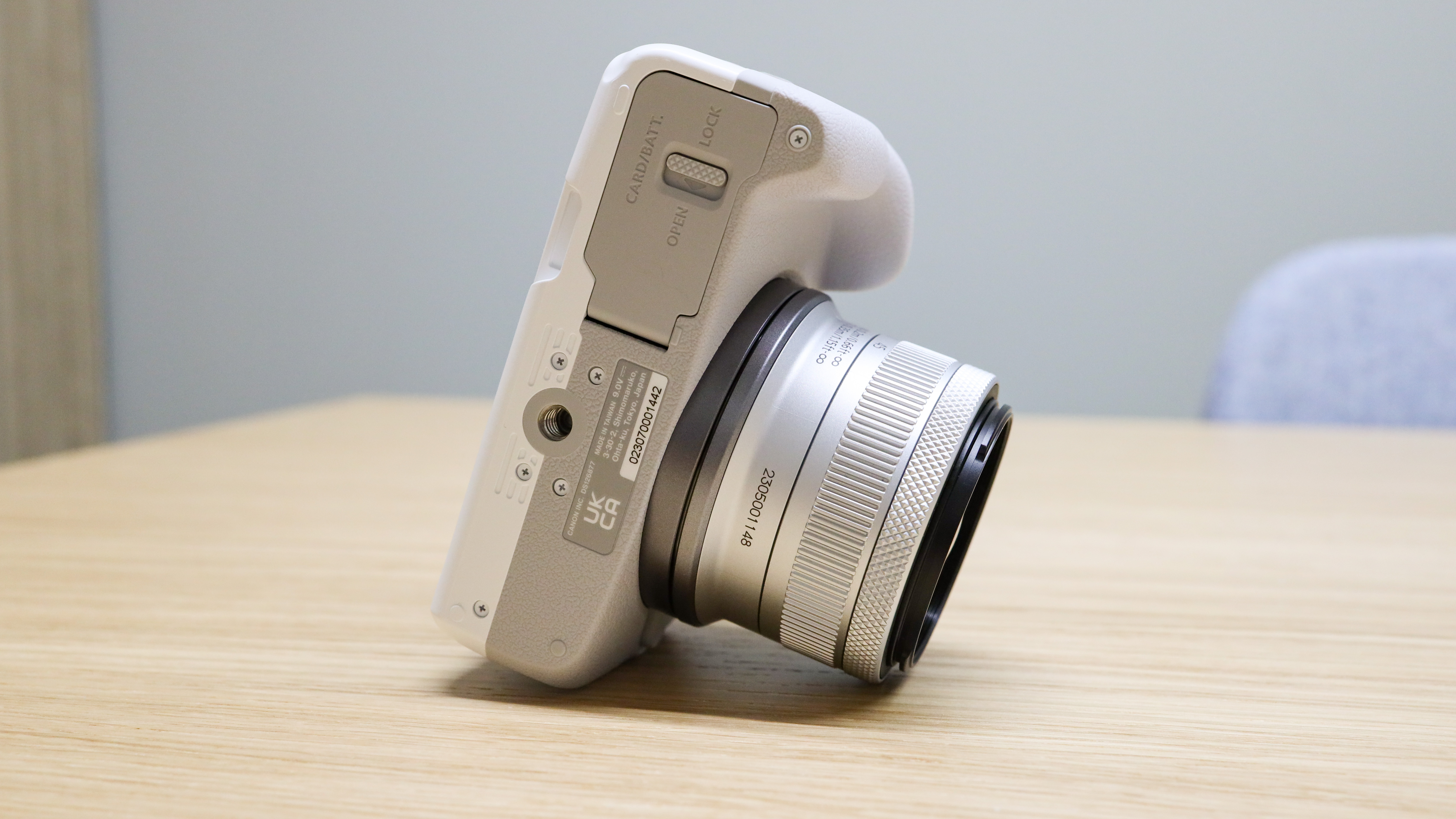
Canon EOS R50: Specifications
Sensor: 24.2MP APS-C (1.6x crop)
Processor: Digic X
Lens mount: Canon RF, RF-S
Autofocus: Dual Pixel CMOS Autofocus II with 4,503 AF positions (3,713 for video)
ISO range: 100-32,000 (exp to 51,200)
Video: 1080p up to 120p, 4K up to 30p (uncropped)
Viewfinder: 0.39 OLED EVF, 2.36 million dots
Memory card: 1x UHS-I SD
LCD: 2.95" fully articulating touchscreen, 1.62 million dots
Max burst: 15fps electronic shutter, 12fps mechanical
In-body image stabilization: None
Connectivity: WiFi, Bluetooth (4.2), UVC, canon.connect, Multifunction Shoe, micro HDMI, USB-C, microphone
Size: 116.3 x 85.5 x 68.8 mm
Weight: Black 328g body only (375g with card and battery) • White 329g (376g)
Canon EOS R50: Key features
The Canon EOS R50 produces 24.2MP still images using its APS-C-sized sensor – which is the same one featured in the Canon EOS R10. It is also capable of 15 frames per second continuous shooting speeds using the electronic shutter, which is incredibly quick and would have been unthinkable for a camera of this size and cost just a few years ago.
The best camera deals, reviews, product advice, and unmissable photography news, direct to your inbox!
The EOS R50 uses the Canon RF mount, which supports RF-S lenses designed for its APS-C lineup of cameras – so it goes without saying that EF-M mount lenses for EOS M cameras will not work with this one, meaning that those hoping for a quick upgrade from the M50 might be disappointed.
Canon's APS-C sensors have a crop factor of 1.6x (unlike the standard 1.5x crop of APS-C sensors from other manufacturers), meaning that the same focal length displayed on your lens is narrower than on a full-frame camera, so this is something to bear in mind if you like to shoot very wide.
Video can be captured in 4K 30p, which has been oversampled from 6K, or in FullHD (1080p) up to 120p. The R50 uses the entire width of the sensor, so there is no forced video crop (unlike the M50 line), though there is the aforementioned 1.6x APS-C crop.
The R50 has no in-body stabilization, but can use Canon's digital stabilization system, or employ the optical stabilization present in most of Canon's lens lineup.
The camera possesses Canon's insanely good Dual Pixel Autofocus, but it is a pared-down AF and does not have the latest subject-tracking additions from Canon's higher-spec cameras, including horses or airplanes. It does have face and eye detection, though it lacks Canon's automatic eye priority (which switches between a subject's closest eye during video recording).
The R50 comes with the usual selection of ports including a micro HDMI, 3.5 audio jack, and USB-C connection. There are also a number of wireless connectivity options with built-in WiFi, Bluetooth 4.2, UVC, image.canon, and the Multifunction Shoe.
There are a number of features specific for content creation, such as a selectable aspect ratio for social media (like natively shooting in 16:9). The R50 can also shoot in vertical orientation and save the end result in a vertical orientation, so that it can be used immediately in mobile apps like TikTok.
There are new creative options in Scene Intelligent Auto. Creative bracketing is one new example, enabling you to automatically apply different creative filters to your images, giving a choice of effects. The camera also has a Panoramic mode that will automatically stitch several images into one panoramic photo, just like your phone.
Canon EOS R50: Build and handling
If you didn't think the EOS R10 could shrink down any further, then think again. The EOS R50 is an even more miniature version of that camera, and it sits very much in the EOS R family of styling, dropping the more boxy hard edges from the M50 for smooth curves.
A few buttons from the R10 have fallen by the wayside, with the R50 more closely resembling its EOS M brethren. On the top there is just one control wheel, a mode select dial, an ISO button, and a record button.
On the rear of the camera there is no joystick, but the usual selection of buttons is there, matching the M50. The inclusion of an articulating touchscreen will make vlogging and shooting at awkward angles much easier.
The camera comes in the usual all-black or is available in a white and silver color combo. Personally I am not a fan of the white camera, as combined with its tiny size I think it makes it look a little like a children's toy rather than a serious bit of photography gear.
Looks-wise, Canon has stuck to its guns with the R50; this looks very much like a Canon camera. For a camera that has a big focus on vlogging, it is notable that Canon has not tried to make this look a little more on-trend with today's image-conscious influencers.
With classic-looking cameras growing in popularity, from the Fujifilm X100V to the Nikon Z fc, Canon seems to believe (or has the sales data to show) that familiar looks and ergonomics over chasing trends is still the winning formula.
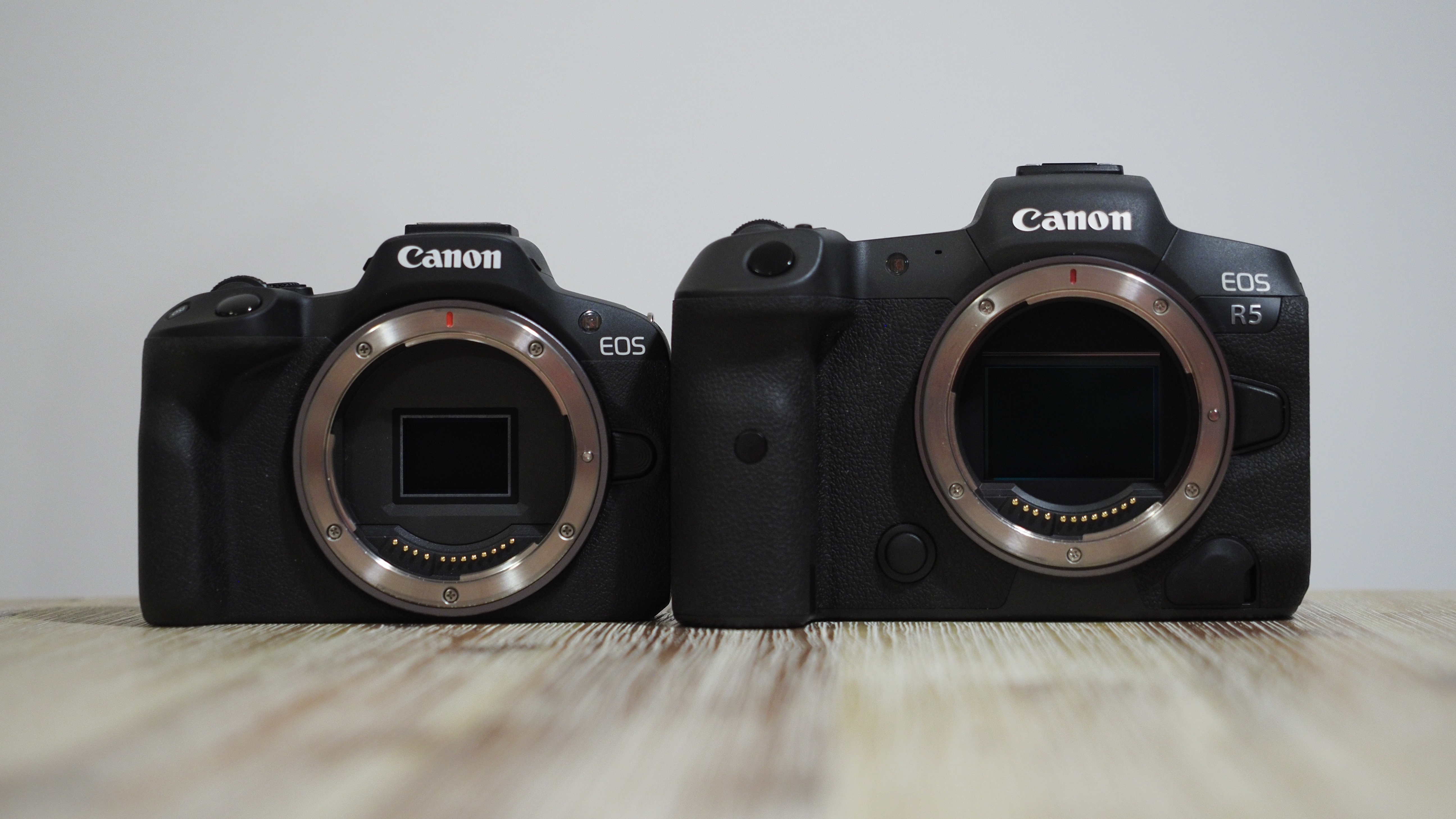
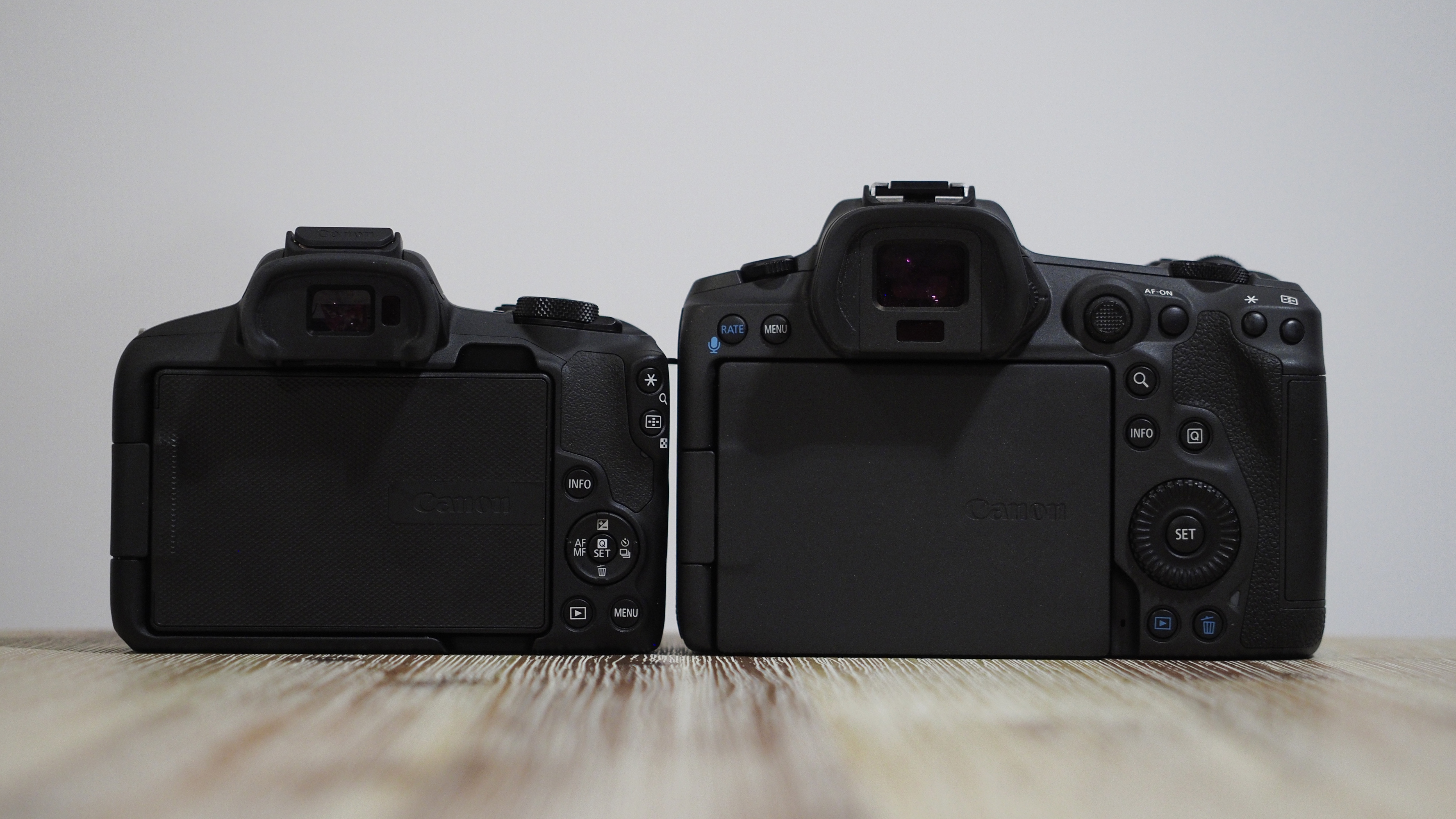
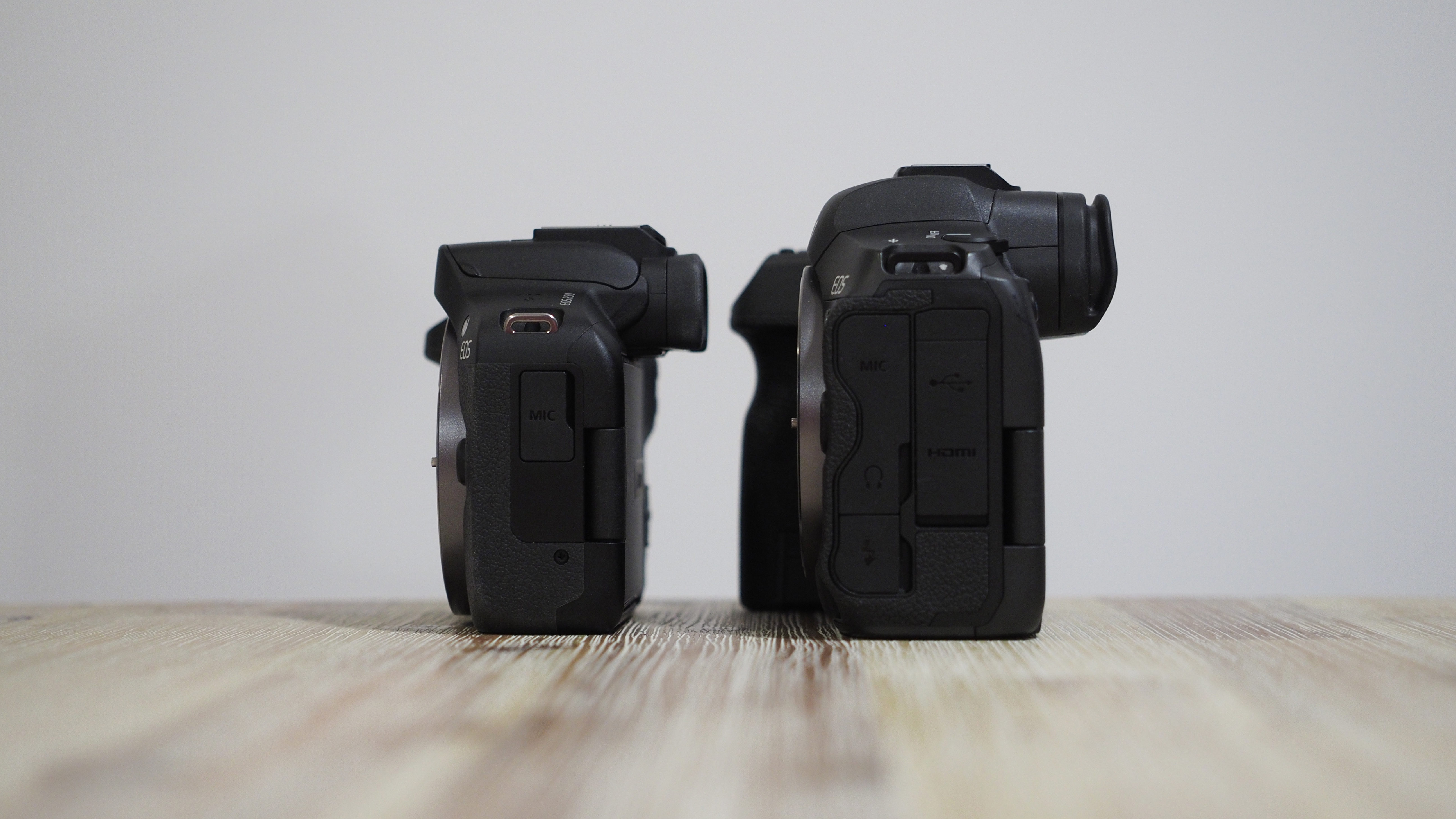
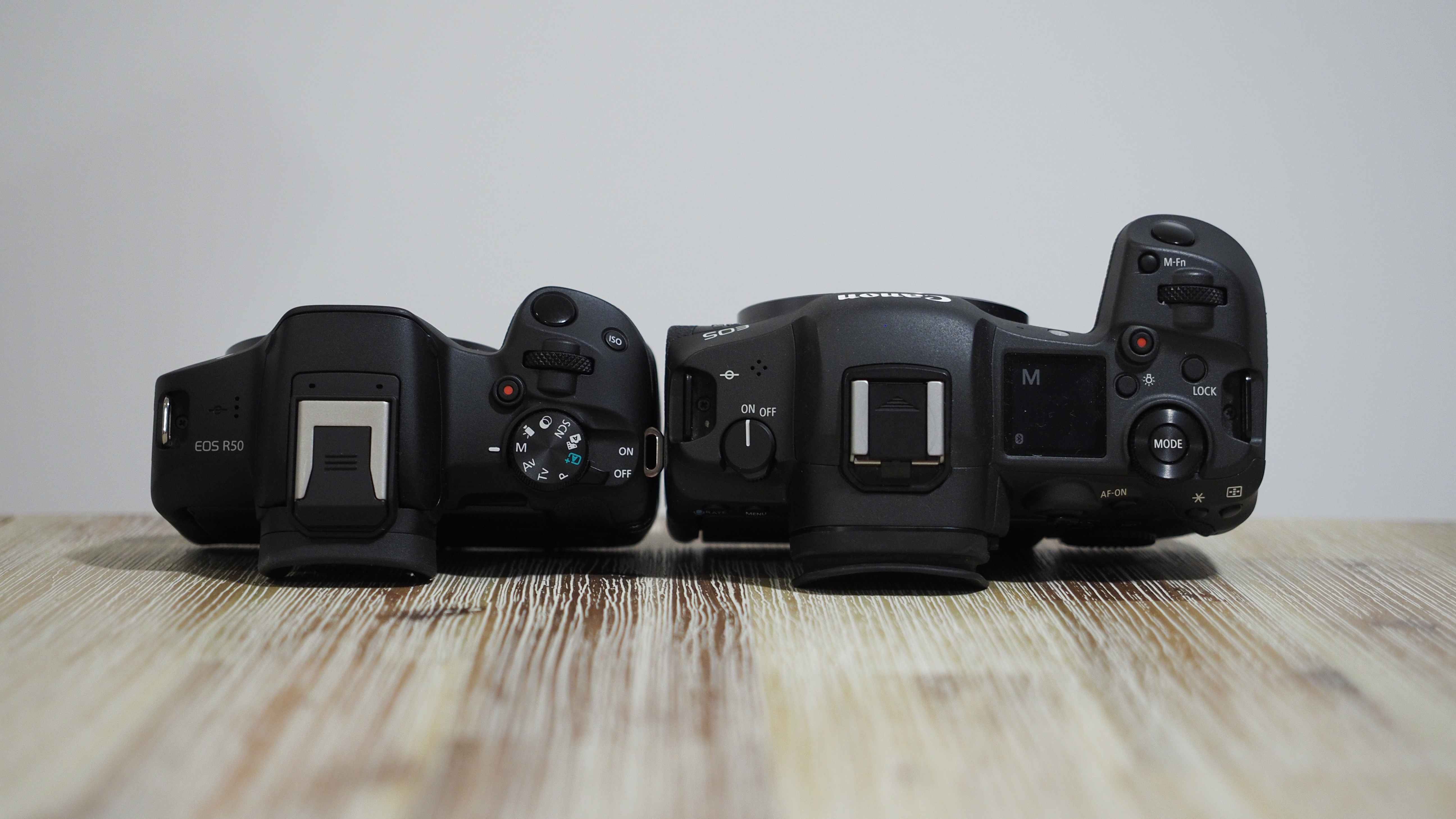
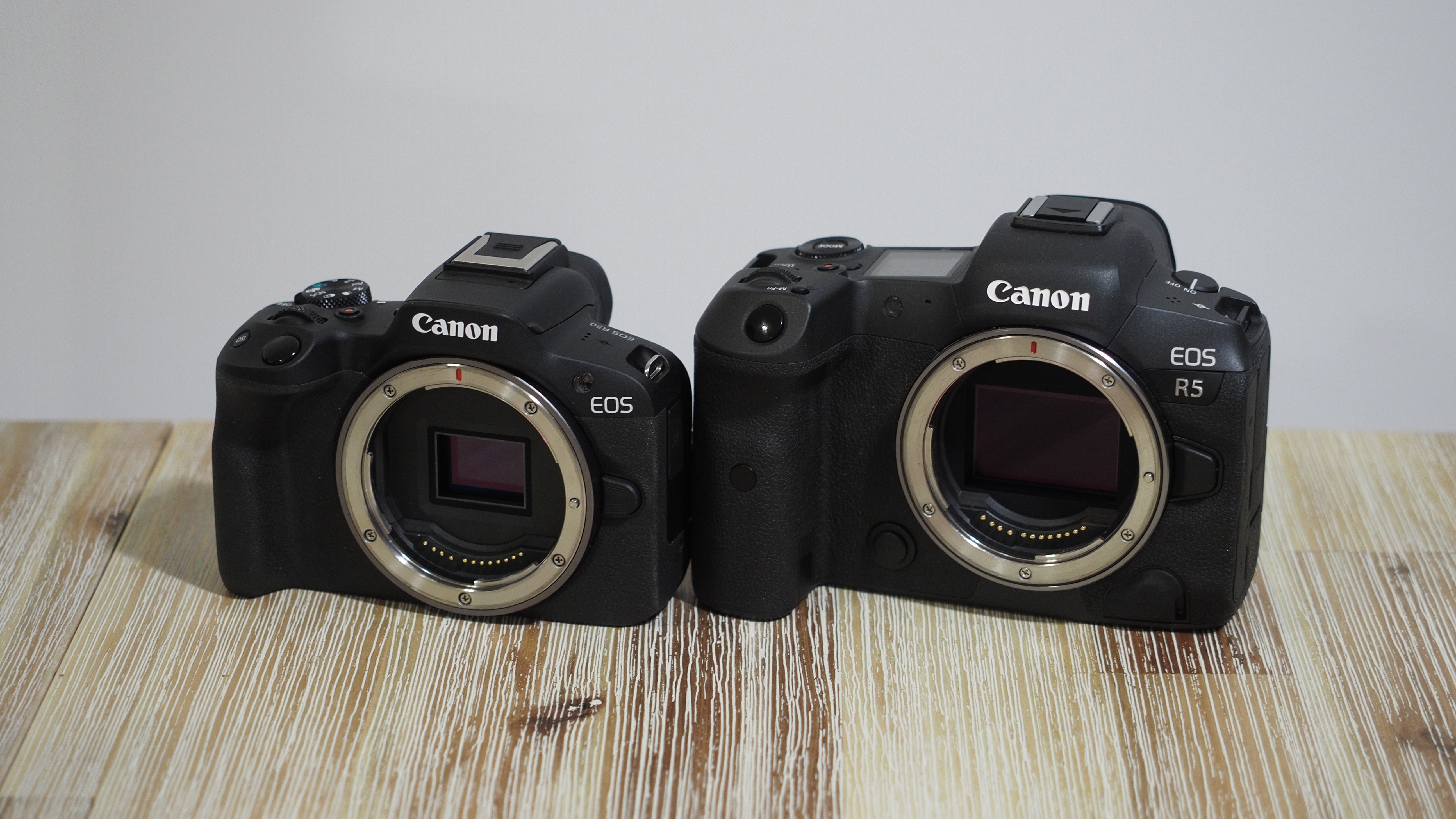
To illustrate just how small it is, this is the size of the Canon EOS R50 (left) next to the full-frame Canon EOS R5 (right).
Canon EOS R50: Performance
While the R50 performs, overall, incredibly similarly to the M50 Mark II, virtually every quibble we had with the M-series camera has been addressed here. This is arguably the M50 Mark II that we should have got back in 2020, and is every inch the upgrade we were expecting.
Photographically, it's hard to fault the R50. All Canon's 24MP APS-C cameras tend to output images broadly of the same quality, but taking the new sensor and processor from the R10 means that the R50 squeezes the most out of every pixel. You still won't want to push the ISO to extremes, but files do feel cleaner than we're used to from the M50.
The beginner-friendly guided shooting will be very welcome to those graduating from smartphones, as Canon expects many users to be, helping them get the most out of a more advanced shooting system. The camera helps anyone unfamiliar with traditional photography use the automatic and semiautomatic modes, which combined with the single control dial makes the process more welcoming.
Of course you can jump into fully manual mode for stills and video as well, though anyone used to having a second exposure dial might find it frustrating having to toggle between functions or use the touchscreen to nudge ISO, shutter and aperture settings.
The AF is very impressive for a camera of this category, and bringing Dual Pixel AF II to its entire mirrorless range is a huge home run for Canon. The tracking modes are very honest, promising that the little square box is focusing on your subject and when you look back at your images – sure enough, the thing that was supposed to be in focus actually is (which can't always be said for other cameras).
This is especially important for video, given that the M50 cameras didn't even offer Dual Pixel AF (which employs phase detection) and only used less-reliable contrast-detect when shooting movies. Thankfully the R50 offers fantastic subject tracking when shooting video, locking onto and tracking eyes even in challenging lighting conditions – which is crucial, as this camera will be as popular among vloggers and content creators as its predecessors.
Video is where one of the biggest differences can be felt, as the R50 can capture 4K video without the nasty crop that plagued the M50. However, you will need to bear in mind that the sensor's 1.6x crop factor will reduce the effective focal length of your glass. In short, it makes your lenses look more "zoomed in" than they would appear on a full frame camera.
Canon wisely introduced the small and affordable Canon RF 16mm f/2 lens, which is the widest prime lens on the system. However, with the 1.6x crop factor, this is effectively a 26mm lens, which may not be wide enough for some folks – especially vloggers who hold the camera at arms length while filming themselves.
This is compounded if you use electronic image stabilization, which further crops into the frame and pushes even closer into the scene. And you'll need to employ electronic stabilization if you're shooting handheld, unless you're using one of the best gimbals, as the Canon EOS R50 doesn't have in-body image stabilization (IBIS).
The video quality of the R50 is great – crisp, clean and clear, with the color accuracy that Canon is known for. Being able to shoot uncropped 4K is a minor revelation for M50 users, and the 6K oversampling almost makes it worth the wait. You can capture FullHD (1080p) all the way up to 120p for slow-motion, though no audio is captured at this frame-rate.
Having the same color science and files with the same editing latitude as other Canon bodies makes workflow easier – but the fact that the R50 uses the RF mount means that this is now a realistic B camera for anyone using another R-system camera, as swapping lenses between the bodies is now an option.
In truth, the R50 is happiest and most effective when paired with the compact RF primes – such as the Canon RF 50mm f/1.8 – or the bundled kit lenses, where it becomes an amazing walkabout, reportage or street photography machine. Larger RF lenses feel very unbalanced on such a tiny body, so be aware of that when considering your lens options.
Canon EOS R50: Sample video
We gave the Canon EOS R50 a real-world test by shooting a YouTube vlog on it, which you can watch above.
Paired with the RF 50mm lens (which became an effective 80mm lens, thanks to the crop factor) its autofocus performed flawlessly, maintaining lock on the eyes and head and never jumping around the frame to other objects of interest.
Since the R50 doesn't have any log recording options, we recorded this video with a slightly flatter exposure and only made a couple of brightness and contrast tweaks in the final output. The addition of the pink FX light didn't affect the camera's ability to capture faithful skin tones, which might seem silly but is a real consideration for content creators whose setups often include colorful light sources.
While we captured audio using a separate lavalier microphone, the R50's internal mic did a commendable job despite being some distance away. It goes without saying that the best microphones for vlogging will make an enormous difference to your audio quality, but the R50's mic does as serviceable a job as any other camera.
The camera stops recording after an hour (a step up from the half-hour limit of the M50), unless you're filming 120p in which case you're limited to 15-minute clips (which is effectively the same thing, as 120p is 4x slow-motion).
Canon EOS R50: Sample images
Canon EOS R50: Lab results
For our lab data comparison, we compared the EOS R50 to its primary entry-level mirrorless APS-C rivals the Nikon Z30 and Sony a6100. The obvious third rival would be a Fujifilm X-mount camera – however, with the Fujfiilm X-T200 now discontinued and the Fujifilm X-T30 II too expensive, we instead included the Canon EOS M50 II, to see how the R50 compares to its EOS-M cousin.
We test resolution using Imatest charts and software, and dynamic range and signal-to-noise ratio with DxO Analyzer.
Resolution (line widths/picture height):
The resolution norm for this sector is 24MP, with both Canon cameras and the Sony having sensors with approximately this pixel count. Consequently these three cameras resolve very similar amounts of fine detail, and narrowly outperform the 20.2MP Z30 in this test.
Dynamic range (EV):
The R50 performs almost identically to the M50 Mark II in terms of dynamic range, though the R50 manages to capture around 1EV extra dynamic range at ISO 6400 and beyond - a possible benefit of its newer Digic X image processor. However, both Canons can't match the Z30's performance in this test, as its lower megapixel count results in larger, more light-sensitive sensor photosites ('pixels').
Signal to noise ratio (decibels):
This test compares the amount of random noise generated by the camera at different ISO settings as a proportion of the actual image information (the 'signal'). Higher values are better and we expect to see the signal to ratio fall as the ISO is increased.
Similar to the dynamic range test, the two Canon cameras are virtually inseparable throughout the tested sensitivity range. Also similar to the previous test is how the Z30 makes use of its lower megapixel count to produce images that are less noisy than those from the R50 at higher sensitivities.
Canon EOS R50: Verdict
The Canon EOS R50 is the perfect companion for content creators and travelers that want a small and simple-to-use camera. An APS-C sensor combined with interchangeable lenses is going to be a step up in quality from any compact camera or camera phone used to create online content.
In particular, those lenses are now from Canon's primary RF lens lineup – its latest, most advanced and best-supported range of optics, rather than the much more limited selection offered by the EF-M mount used by the M50. And of course, you can mount Canon's EF-mount DSLR lenses using an affordable adapter.
With the guided UI and Canon's straightforward menus, it couldn't be simpler to use. With a solid spec sheet, including 24.2MP still images and 4K video, you can get a lot of quality from this tiny camera.
Canon has also gone a long way to make connecting a camera to a phone or laptop as simple as possible, with several different methods of wirelessly transferring files, removing the barriers that might slow workflows previously so that content can get online faster.
The Canon EOS R50 is friendly to newcomers, but is also a deceptively powerful tool for more advanced users. Its 4K video (6K-oversampled) offers great quality footage, the autofocus system trumps anything else in the category, and you get blistering 15fps stills shooting for fast-moving subjects.
Aside from the lack of image stabilization (which is fair and expected, at this price point) and the crop factor for video (which is inherent to APS-C cameras), there is nothing to complain about here. If you're looking for the most affordable route into the EOS R system, and a great all-purpose camera that's small enough to take anywhere, it's looking right back at you.

Gareth is a photographer based in London, working as a freelance photographer and videographer for the past several years, having the privilege to shoot for some household names. With work focusing on fashion, portrait and lifestyle content creation, he has developed a range of skills covering everything from editorial shoots to social media videos. Outside of work, he has a personal passion for travel and nature photography, with a devotion to sustainability and environmental causes.
